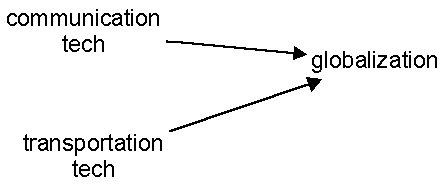
Technological change breeds technological change. This is because technological change is a function of knowledge, and knowledge is increasing rapidly. This is a function many things, including:
The rate of change is itself changing (getting faster) because most innovations are produced not as a result of new knowledge, but of recombinations of old knowledge. And the number of possible combinations increases exponentially with the number of bits being combined. Here is a chart of the number of combinations of things, given that you have 1 thing, 2 things, 3 things, etc. up to 11 things.
|
Bits |
Combinations |
|
5 |
32 |
|
10 |
1024 |
|
20 |
1048576 |
|
30 |
1073741824 |
|
40 |
1.09951E+12 |
Of course, most combinations of knowledge chunks are useless -- combining the technology in a hair dryer with the technology for door hinges probably gets you nothing. But if just 1 in one billion combinations produced something useful, the rate of new product innovation would be absolutely staggering.
So it's not surprising that when we look at the number of innovations in human societies over the last 250 thousand years, we find very little change for 99% of the that time. By most estimates, there has been as much technological change in the last 250 years as there has been in the preceding 250 thousand years.
So what does this have to do with organizations? Well, for one thing, organizations are strongly affected by the available technology. The fact that transportation, communication and information technologies have changed so much in just the last 50 years has completely transformed how business is done. Two hundred and fifty years ago it took months to get a message from New York to Japan. Today, you can talk to people on the phone, in real time, anywhere on the planet (and a little beyond!). You can get an object, such as a product, into someone's hands in any major city on the planet in about 20 hours. So now it is reasonable to not only have global customers, but to have offices around the world, and to have organizational functions, like manufacturing or design, spread out across the world.
So, one huge trend of the last 250 years has been globalization -- the exponential growth of truly global organizations. The key benefit of global organizations is the ability to exploit regional differences in needs (customers) and production capabilities (worker expertise, costs, government aid, etc.). In addition, the markets in many countries have become largely saturated for many products. For example, to grow the market for televisions in the United States, manufacturers either have convince users to have multiple televisions, or they have to make them obsolete over time, or convince people to have more children, because at this point, virtually every person who could conceivably afford and use a television has one.

Increased globalization has had a number of effects. In combination with changing demographics (e.g., minorities in the US have greater fertility rates, so the share of minorities in the workplace is increasing), globalization is causing a rapid increase in diversity in both the marketplace and the workplace. More than ever, people have to interact with and coordinate with people who are different from themselves on a number of different biological and cultural dimensions. This in turn has meant that employees need new relational skills to succeed. A typical manager at CitiBank has to be able to spend several years at CitiBank offices around the world, and not just places like Europe, but exotic places like Guatemala, or Ethiopia. While in those places, managers have to learn how to work with people that do things differently -- do things in ways that are personally repugnant to them.
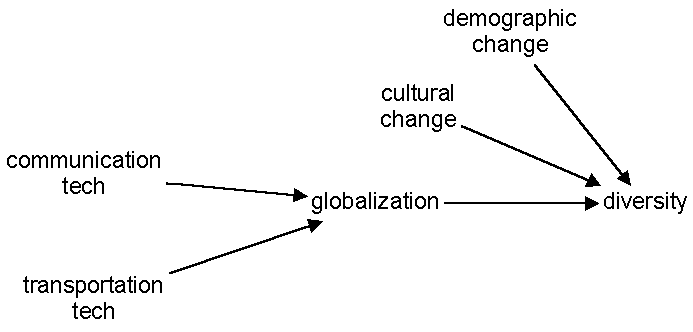
At the same time, organizations need new coordinating mechanisms to accommodate different kinds of people in the workplace. For example, as more women have entered the workforce, organizations have had to deal with a whole range of issues, including sexual harassment and pregnancy. The response to increased diversity has, in many cases, been increased organizational flexibility. Some organizations allow different workers to have very different work and payment schedules, such as "fast tracks" and "mommy tracks", full-time and part-time. Many organizations (and workers) have found it convenient to treat some workers as independent consultants rather than employees. In certain occupations, advances in communication and information technologies have enabled "telecommuting" -- working at home via computer.
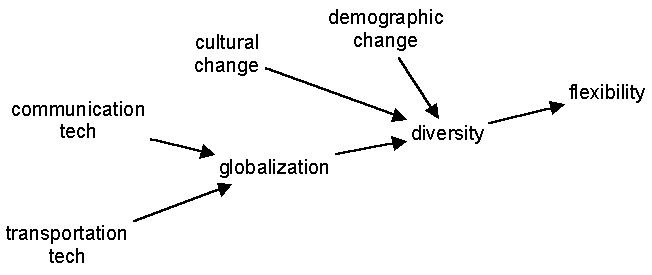
Another effect of globalization is increased competition. Back when national borders effectively sealed off national economies, the major competitors for any given company were usually local. For example, in the car industry, each industrialized country might have 3 or 4 major auto makers, of which one was usually dominant. Splitting up a market among 3 or 4 players, some of whom could be quite weak, was often a less than challenging affair. But once globalization made it possible for companies all over the world to compete, the number of players went up radically, and more importantly, the number of really good competitors (the top players in each national market) went up as well.
With increased competition comes an even faster pace of change, as each competitor introduces innovations in order to outsell their competitors.
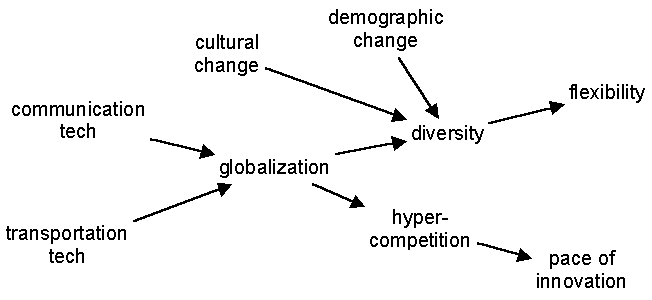
This in turn creates a situation in which organizational response time is at a premium -- those organizations that can develop new technologies faster, or which can adapt to changes in the market faster, are the ones that will survive the competition. To maximize response time, organizations have been flattening, downsizing, and networking. Flat organizations make decisions more quickly because each person is closer to the ultimate decision-makers. Smaller organizations are faster because there are simply fewer different things going on -- fewer competing goals, fewer people to coordinate, etc.
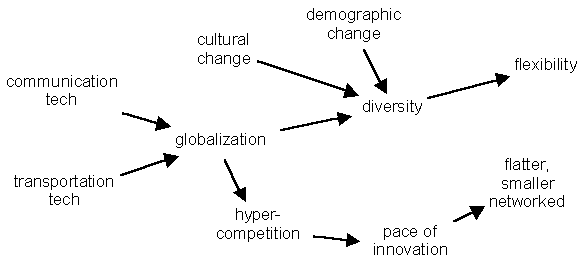
Organizations that flatten tend to simultaneously encourage horizontal communication among workers. Rather than work through the hierarchy, it is often faster for workers that need to coordinate with each other to simply communicate directly. (It can also lead to chaos -- there is a downside.) Such organizations are said to be highly networked.
Another meaning of network organizations refers to their relations to other organizations. Organizations that have downsized to just their core competencies must then outsource all the functions that used to be done in-house. To avoid losing time and effort managing contracts with suppliers, organizations have learned to develop very close ties to their suppliers, so that social mechanisms of coordination replace legal mechanisms, which are slow and costly. In many industries, such as the garment industry in Italy, strong relationships have developed between manufacturers and suppliers (and other manufacturers), so that considerable work is done without a contract and without even working out a firm price.
Network organizations are particularly important in industries with complex products where technologies and customer needs change rapidly, such as in high tech. Close ties among a set of companies enables them to work with each other in ways that are faster than arms-length contracts would permit, and yet retains the flexibility of being able to drop the relationship if needed (as opposed to performing the function in-house).
In summary, the end of the 20th century is seeing a sea change in the way business does business. This contrasts hugely with the relative lack of change that we saw in the first few million years of human history.